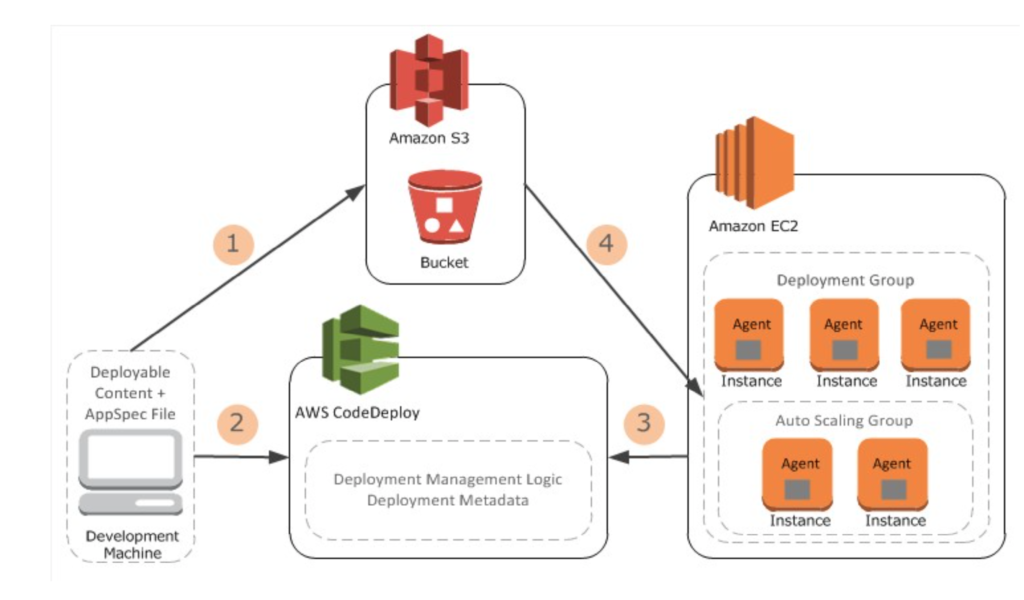AWS DevOps
DevOps is the combination of processes, practices, and tools that increases an organization’s ability to deliver applications and services at high velocity: evolving and improving products at a faster pace than organizations using traditional software development and infrastructure management processes. This speed enables organizations to better serve their customers and compete more effectively in the market.
As more organizations are digitally transforming themselves, there is a shift toward the Cloud, Agile, and DevOps. Systems are becoming increasingly complex comprising many technologies, integrations, and a fast pace of change. DevOps has become an integral part of the overall digital infrastructure and the way software is developed, tested, deployed, and run.
AWS provides a set of flexible services designed to enable companies to more rapidly and reliably build and deliver products using AWS and DevOps practices. These services simplify provisioning and managing infrastructure, deploying application code, automating software release processes, and monitoring your application and infrastructure performance.

Drona Labs helps you manage your transition to AWS and the overall DevOps as a Service on AWS.
AWS DevOps Services
Drona Labs helps build a continuous integration and delivery capability without
managing servers or build nodes, leverage Infrastructure as Code to provision and
manage your cloud resources in a consistent and repeatable manner.
Our key services are listed below:
Continuous Integration:
We help setup processes and systems where developers regularly merge their code changes into a central repository, after which automated builds and tests are run. The key goals of continuous integration are to find and address bugs quicker, improve software quality, and reduce the time it takes to validate and release new software updates.

Continuous Delivery:
We design and deploy systems that enable code changes to be automatically built, tested, and prepared for a release to production. It expands upon continuous integration by deploying all code changes to a testing environment and/or a production environment after the build stage. When continuous delivery is implemented properly, developers will always have a deployment-ready build artifact that has passed through a standardized test process.
Infrastructure as Code:
Here we use code, tools such as CloudFormation, CDK, Terraform, and software development techniques such as version control and continuous integration to setup, configure, and deploy infrastructure. The cloud’s API-driven model enables developers and system administrators to interact with infrastructure programmatically, and at scale, instead of needing to manually set up and configure resources. Thus, engineers can interface with infrastructure using code-based tools and treat infrastructure in a manner similar to how they treat application code. Because they are defined by code, infrastructure and servers can quickly be deployed using standardized patterns, updated with the latest patches and versions, or duplicated in repeatable ways.

• Configuration Management
Developers and system administrators use code to automate operating system and host configuration, operational tasks, and more. The use of code makes configuration changes repeatable and standardized. It frees developers and systems administrators from manually configuring operating systems, system applications, or server software.
• Policy as Code
With infrastructure and its configuration codified with the cloud, organizations can monitor and enforce compliance dynamically and at scale. The infrastructure that is described by code can thus be tracked, validated, and reconfigured in an automated way. This makes it easier for organizations to govern changes over resources and ensure that security measures are properly enforced in a distributed manner (e.g., information security or compliance with PCI-DSS or HIPAA). This allows teams within an organization to move at higher velocity since non-compliant resources can be automatically flagged for further investigation or even automatically brought back into compliance.
Monitoring and Logging:
We enable organizations to see how application and infrastructure performance impacts the experience of their product’s end user. By capturing, categorizing, and Drona Labs Inc. Page 6 of 19 then analyzing data and logs generated by applications and infrastructure, organizations understand how changes or updates impact users, shedding insights into the root causes of problems or unexpected changes. Active monitoring becomes increasingly important as services must be available 24/7 and as application and infrastructure update frequency increases. Creating alerts or performing real-time analysis of this data also helps organizations more proactively monitor their services.
Security:
Whether you are going through a DevOps Transformation or implementing DevOps principles for the first time, you should think about Security as integrated into your DevOps processes. This should be a cross-cutting concern across your build, test deployment stages. Your continuous integration and continuous delivery (CI/CD) pipelines and related services should be safeguarded, and proper access control permissions should be setup. After studying your application, infrastructure, and use-cases, Drona Labs carries out a security and threat assessment. We then design and implement security policies and safeguards using the least-privilege permissions model, AWS Identity Access Management, Secrets Manager, Config, CloudWatch, VPC, WAF, and security groups and policies.
